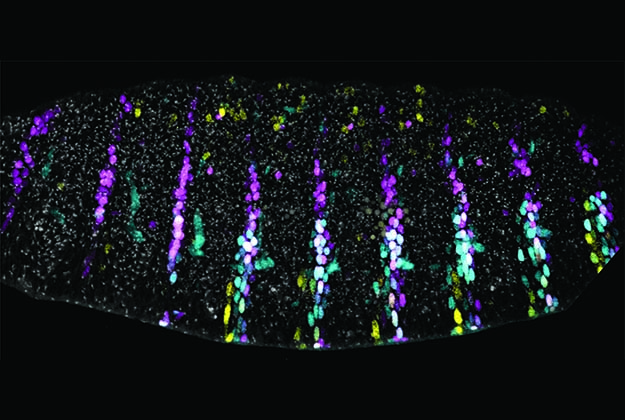
Transcriptional hubs confer phenotypic robustness
Enhancers in Drosophila embryos gather to preserve phenotypes under stressful conditions

As an embryo develops from an initial group of similar cells, precise patterns of gene expression determine how these cells differentiate into various cell types. The gene expression patterns are controlled by regions of DNA called enhancers, which are bound by molecules known as transcription factors.
EMBL scientists from the Crocker group have previously shown that multiple sections of DNA that contain enhancers for the same gene can physically gather together to form a microenvironment within the cell’s nucleus – a transcriptional ‘hub’. These hubs are enriched for both enhancers and transcription factors, providing a mechanism to keep the expression of their corresponding gene more consistent and more resistant to the failure of a single enhancer.
Now they have demonstrated that, even when one of these enhancers is deleted from its original location and inserted into a different chromosome of the Drosophila melanogaster genome, it is still able to find its way to the same hub. Their results, published in eLife on 11 July, show that these adaptable transcriptional hubs help preserve the phenotype of an organism developing under environmental stress.
The researchers first removed an enhancer from the Drosophila genome that boosts the expression of a gene responsible for making ‘hooks’, known as trichomes, on the epidermis of fly larvae. Under normal conditions, no defects were observed, but under the stress of high temperature, embryos developed abnormally low numbers of trichomes.
The researchers then moved the enhancer region to a different chromosome. Despite the high temperature, the embryos were now able to develop enough trichomes. The region of DNA containing the enhancer had moved to the same hub as the original gene, reinforcing gene expression and preserving the phenotype.
This research provides new insight into how embryos are robust to environmental and genetic stresses through cooperative interactions across the genome. Researchers must now ask how this robustness occurs in living embryos. How do these hubs form? What are the necessary components and conditions? This system opens new avenues for developmental biologists to explore fundamental questions related to gene expression, evolution, and development.


